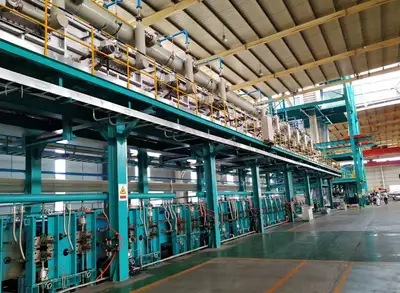In the world of industrial corrosion protection, consistency is the hallmark of quality. For hot dip galvanizing line, perhaps no factor is more critical than maintaining uniform coating thickness across every steel component. Variations in thickness not only represent inefficient use of materials but can lead to premature failure in thinner sections or brittleness in overly thick areas. HiTo Engineering has mastered the science and art of delivering exceptional consistency in coating thickness through integrated technological solutions, precise process control, and deep metallurgical expertise. Their systematic approach ensures that every beam, bracket, and fabrication emerges from the galvanizing line with a optimally protective zinc coating that meets exact specifications, project after project.
The Critical Importance of Coating Uniformity
The protective value of a galvanized coating is directly proportional to its consistency. A non-uniform coating creates weak points where corrosion can initiate, undermining the entire purpose of the process. Variations can result from numerous factors: fluctuations in bath temperature, inconsistent immersion times, inadequate surface preparation, or irregular chemical compositions. HiTo Engineering approaches thickness control as a comprehensive system rather than a single-step concern, recognizing that consistency must be engineered into every phase of the operation. Their holistic methodology addresses both the microscopic interactions at the steel-zinc interface and the macroscopic handling of components through the production line.

Precision Surface Preparation: The Foundation of Uniformity
Long before steel touches molten zinc, HiTo's process ensures perfect surface conditions for consistent coating adhesion. Their automated pre-treatment lines maintain exacting standards in cleaning, pickling, and fluxing stages. Alkaline cleaning solutions are maintained at precise concentrations and temperatures to completely remove organic contaminants without etching the surface unevenly. Acid pickling baths are continuously monitored and adjusted to ensure uniform removal of mill scale and rust. The flux application, particularly in HiTo's preferred dry method, creates a perfectly uniform layer that promotes even zinc wetting. This meticulous preparation eliminates variables that could cause irregular iron-zinc reactions during immersion.
Advanced Bath Management and Composition Control
At the heart of HiTo's thickness control system lies precise management of the molten zinc bath itself. The company employs sophisticated heating systems that maintain bath temperature within a remarkably narrow range (±5°C) of the optimal 449-454°C (840-850°F) window. This temperature precision is crucial as even minor fluctuations significantly affect zinc fluidity and reactivity. Beyond temperature, HiTo carefully controls the bath's chemical composition, particularly the aluminum content which influences coating structure and thickness. Regular sampling and analysis ensure the bath remains within specified parameters, preventing the formation of excessively thick brittle layers or uneven coating development.
Automated Handling and Immersion Techniques
HiTo Engineering has revolutionized coating consistency through engineered handling solutions that eliminate human variability. Their automated hoists follow precisely programmed immersion and withdrawal sequences, controlling the angle and speed at which steel enters and exits the zinc bath. This mechanized approach ensures identical processing for every load, allowing dissolved gases to escape uniformly and preventing air pockets that create uncoated areas. The withdrawal speed is particularly crucial—too fast results in excessive zinc pickup, too slow causes irregular drainage patterns. HiTo's programmed systems maintain optimal withdrawal rates that promote even zinc drainage and minimize drip formations.

Real-Time Monitoring and Adaptive Control Systems
During the galvanizing process itself, HiTo implements advanced monitoring technologies that provide unprecedented process control. Infrared thermal imaging cameras track temperature distribution across components as they exit the zinc bath, identifying potential cold spots that might affect solidification patterns. Laser measurement systems occasionally sample coating thickness in real-time, allowing operators to make immediate adjustments to process parameters. These adaptive control systems can automatically fine-tune immersion times, withdrawal speeds, or bath temperatures based on continuous feedback, creating a closed-loop system that constantly self-optimizes for thickness consistency.
Comprehensive Quality Assurance and Continuous Improvement
HiTo's commitment to consistency extends beyond the production line to rigorous quality assurance protocols. Every galvanized component undergoes meticulous inspection using magnetic thickness gauges that verify coating thickness at multiple points according to international standards. This data is systematically recorded and analyzed to identify trends and potential process deviations. Perhaps most importantly, HiTo views each project as an opportunity for refinement, using collected data to continuously improve their processes. This culture of continuous improvement, combined with their integrated technological systems, ensures that HiTo Engineering consistently delivers galvanized steel products with exceptional coating uniformity that provides decades of reliable corrosion protection.




Comments